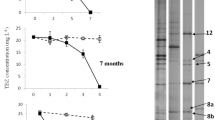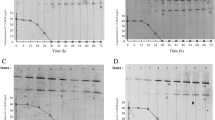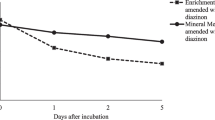Abstract
Agent Orange contaminated soils were utilized in direct enrichment culture studies to isolate 2,4,5-trichlorophenoxyacetic acid (2,4,5-T) and 2,4-dichlorophenoxyacetic acid (2,4-D) mineralizing bacteria. Two bacterial cultures able to grow at the expense of 2,4,5-T and/or 2,4-D were isolated. The 2,4,5-T degrading culture was a mixed culture containing two bacteria, Burkholderia species strain JR7B2 and Burkholderia species strain JR7B3. JR7B3 was able to metabolize 2,4,5-T as the sole source of carbon and energy, and demonstrated the ability to affect metabolism of 2,4-D to a lesser degree. Strain JR7B3 was able to mineralize 2,4,5-T in pure culture and utilized 2,4,5-T in the presence of 0.01 yeast extract. Subsequent characterization of the 2,4-D degrading culture showed that one bacterium, Burkholderiaspecies strain JRB1, was able to utilize 2,4-D as a sole carbon and energy source in pure culture. Polymerase chain reaction (PCR) experiments utilizing known genetic sequences from other 2,4-D and 2,4,5-T degrading bacteria demonstrated that these organisms contain gene sequences similar to tfdA, B, C, E, and R (Strain JRB1) and the tftA, C, and E genes (Strain JR7B3). Expression analysis confirmed that tftA, C, and E and tfdA, B, and C were transcribed during 2,4,5-T and 2,4-D dependent growth, respectively. The results indicate a strong selective pressure for 2,4,5-T utilizing strains under field condition.
Similar content being viewed by others
References
PS Amy JW Schulke LM Frazier RJ Seidler (1985) ArticleTitleCharacterization of aquatic bacteria and cloning of genes specifying partial degradation of 2,4-dichlorophenoxyacetic acid Appl. Environ. Microbiol. 49 1237–1245
CE Danganan S Shankar RW Ye AM Chakrabarty (1995) ArticleTitleSubstrate diversity and expression of the 2,4,5-trichlorophenoxyacetic acid oxygenase from Burkholderia cepacia AC1100 Appl. Environ. Microbiol. 61 4500–4504
DL Daubaras CE Danganan A Hubner RW Ye W Hendrickson AM Chakrabarty (1996) ArticleTitleBiodegradation of 2,4,5-trichlorophenoxyacetic acid by Burkholderia cepacia strain AC1100: evolutionary insight Gene 179 1–8
RH Don JM Pemberton (1985) ArticleTitleGentic and physical map of the 2,4-dichlorophenoxyacetic acid-degradative plasmid pJP4 J. Bacteriol. 161 466–468
JT Fleming J Sanseverino GS Salyer (1993) ArticleTitleQuantitative relationship between naphthalene catabolic gene frequency and expression in predicting PAH degradation in soils at town gas manufacturing sites Environ. Sci. Technol. 27 1068–1074
RR Fulthorpe C McGowen OV Maltseva WE Holben JM Tiedje (1995) ArticleTitle2,4-dichlorophenoxyacetic acid-degrading bacteria contain mosaics of catabolic genes Appl. Environ. Microbiol. 61 3274–3281
MR Gis L Xun (2003) ArticleTitleCharacterization of chlorophenol 4-monooxygenase (TftD) and NADH: flavin adenine dinucleotide oxidoreductase (TftC) of Burkholderia cepacia AC1100 J. Bacteriol. 185 2786–2792
LA Golovleva RN Pertsova LI Evtushenko BP snf Baskunov (1990) ArticleTitleDegradation of 2,4,5-trichlorophenoxyacetic acid by a Nocardioides simplex culture Biodegradation 1 263–271
AR Harker RH Olsen RJ Seidler (1989) ArticleTitlePhenoxyactetic acid degradation by the 2,4-dichlorophenoxyacetic acid (TFD) pathway of plasmid pJP4: mapping and characterization of the TFD regulatory gene, tfdR J. Bacteriol. 171 314–320
KH Hecker KH Roux (1996) ArticleTitleHigh and low annealing temperatures increase both specificity and yield in touchdown and stepdown PCR Biotechniques 20 478–485
ST Kellogg DK Chatterjee AM Chakrabarty (1981) ArticleTitlePalsmid-assisted molecular breeding: new technique for enhanced biodegradation of persistent toxic chemicals Science 214 1133–1135
JJ Kilbane DK Chatterjee JS Karns ST Kellogg AM Chakrabarty (1982) ArticleTitleBiodegradation of 2,4,5-trichlorophenoxyacetic acid by a pure culture of Pseudomonas cepacia Appl. Environ. Microbiol. 44 72–78
DJ Lane (1991) 16S/23S rDNA Sequencing E Stackenbrandt M Goodfellow (Eds) Nucleic Acid Techniques in Bacterial Systematics John Wiley and Sons Chister, West Sussex 115–148
A Nagel JT Fleming GS Sayler (1999) ArticleTitleReduction of false positives in prokaryotic mRNA differential display Biotechniques 26 641–648
J Sambrook EF Fritsch T Maniatis (1989) Molecular Cloning: A Laboratory Manual EditionNumber2 Cold Spring Harbor Laboratory Cold Spring Harbor, NY
Tiedje JM, Fulthorpe R, Kamagata Y, McGowan C, Rhodes A & Takami H (1997) What is the global pattern of chloroaromatic degrading microbial populations, In: Horikoshi K, Fukuda M & Kudo T (Eds) Microbial Diversity and Genetics of Biodegradation, Science 65–74
M Vaneechoutte P Kämpfer T Baere ParticleDe E Falsen G Verschraegen (2004) ArticleTitleWautersia gen nov., a novel genus accommodating the phylogenetic lineage including Ralstonia eutropha and related species, and proposal of Ralstonia [Pseudomonas] syzygii (Roberts et al. 1990) Comb. nov. Int. J. Syst. Envol. Microbiol. 54 317–327
WG Weisburg SM Barns DA Pelletier DJ Lane (1991) ArticleTitle16S ribosomal DNA amplification for phylogenetic study J. Bacteriol. 173 697–703
Author information
Authors and Affiliations
Corresponding author
Rights and permissions
About this article
Cite this article
Rice, J.F., Menn, F.M., Hay, A.G. et al. Natural selection for 2,4,5-trichlorophenoxyacetic acid mineralizing bacteria in agent orange contaminated soil. Biodegradation 16, 501–512 (2005). https://doi.org/10.1007/s10532-004-6186-8
Issue Date:
DOI: https://doi.org/10.1007/s10532-004-6186-8




